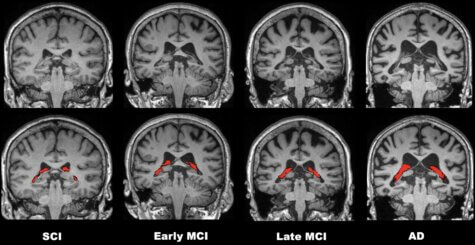OAK BROOK, Ill. — Brain scans discovering a key sign of cognitive decline could help doctors spot Alzheimer’s before symptoms ever begin, a new study reveals. Scientists with the Radiological Society of North America have linked increased volume in a brain region called the choroid plexus to greater cognitive impairment.
The discovery offers hope of a screening program to identify vulnerable individuals. Detecting early changes of the disease is vital to developing new treatments.
To date, drugs trials have failed because they test medications on patients after the disease has taken hold. The choroid plexus is a network of blood vessels, connective tissue, and cells found in spaces called ventricles. It acts as a gateway for immune cells from the blood and also produces cerebrospinal fluid. CSF washes away waste products and rogue proteins called amyloid and tau. When these proteins build up in the brain, they kill neurons, leading to dementia.
“Researchers believe impaired clearance rather than overproduction of abnormal amyloid and tau is responsible for Alzheimer’s disease,” says senior author Professor Won-Jin Moon of Konkuk University in a media release.
“Thus, we assume that the abnormal status of choroid plexus is linked to the failure of clearance leading to waste and toxic protein accumulation in the brain and failure of immune surveillance leading to neuroinflammation.”
The findings could lead to early dementia intervention
The findings are based on MRI (magnetic resonance imaging) scans of 532 people at various stages of cognitive impairment. Choroid plexus mass was greater in those with Alzheimer’s, with bigger size correlating with worsening memory.
It also had negative effects on executive function, which is a wide-ranging set of mental skills governing things like self-control and planning. Previously, little was known about the choroid plexus’ imaging profile in cognitive impairment.

“Our study found that the enlarged choroid plexus volume is independently associated with increased cognitive impairment,” Dr. Moon says.
“We found no relationship between choroid plexus volume and amyloid pathology but a clear relationship between the choroid plexus volume and cognitive impairment severity.”
The results in the journal Radiology point to new possibilities for MRI’s role in the diagnosis of Alzheimer’s.
“I think our findings on the choroid plexus can suggest it as a new potential MR imaging surrogate for an impaired clearance system and neuroinflammation,” the researcher continues.
Other potential clinical applications include helping researchers develop new target drugs or treatments. Eventually, choroid plexus measurements could help speed therapy to those who need it most.
“If we combine choroid plexus volume and hippocampal volume in a screening stage, it may help us better discriminate the more vulnerable patients from the less vulnerable ones,” Dr. Moon explains.
Alzheimer’s continue to rise worldwide
The researchers are planning a follow-up study that will track patients over a long period of time. They will explore changes in choroid plexus volume as the disease progresses.
The number of dementia cases worldwide will triple to more than 150 million in the next three decades, according to estimates. Current drugs can treat the symptoms, but not the cause.
Toxic forms of amyloid and tau build up as cells in the brain can no longer clear them away. The choroid plexus produces around 400 ml of cerebrospinal fluid (CSF) — a clear liquid that surrounds the brain and spinal cord — each day.
South West News Service writer Mark Waghorn contributed to this report.

